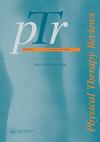The pain attitudes and beliefs scale for physiotherapists: psychometric properties of the Croatian version
IF 0.8
Q4 REHABILITATION
引用次数: 0
Abstract
AbstractObjective This study aims to create a Croatian version of the PABS-PT questionnaire and determine the psychometric properties.Design This study is a cross-sectional survey of Croatian physiotherapists.Methods The Pain Attitudes and Beliefs Scale for Physiotherapists is a questionnaire that includes 36 items. Only physiotherapists working with patients suffering from low back pain and who have been working for at least 1 year in the field of musculoskeletal physiotherapy participated in the study. The Factor and Cronbach’s alpha analyses were performed to determine the factor structure and internal consistency.Results A total of 203 physiotherapists (response rate 69.52%) completed the PABS-PT-CRO. The analysis reveals two factors, i.e. a biomedical and biopsychosocial treatment orientation. The two-factor structure explained 25.8% of the total variance, with factor 1 contributing 17.8% and factor 2 contributing 8%. Thirty-six items were reduced to fifteen, with ten items loading on factor 1 and five on factor 2. Cronbach’s alpha was 0.762 for factor 1 (biomedical scale) and 0.666 for factor 2 (biopsychosocial scale).Conclusion The Croatian version of the PABS-PT appears to be equivalent to the original Dutch version and indicates a similar internal consistency. The questionnaire is valuable and necessary in clinical work for physiotherapists.Keywords: Biopsychosocialattitudephysiotherapistlow back painpsychometric properties Author contributionsBoth authors contributed to the conception and design of the study, data analysis, writing, and revising the manuscript. MB was responsible for data collection.Ethical approvalThis study was approved by the Ethics Committee at the Clinical Hospital Sveti Duh.Disclosure statementNo potential conflict of interest was reported by the author(s).Additional informationFundingThe author(s) reported there is no funding associated with the work featured in this article.物理治疗师的疼痛态度和信念量表:克罗地亚版本的心理测量特性
摘要目的编制克罗地亚语版PABS-PT问卷,并测定问卷的心理测量特征。本研究是对克罗地亚物理治疗师的横断面调查。方法采用包含36个项目的《物理治疗师疼痛态度与信念量表》问卷。只有在肌肉骨骼物理治疗领域工作至少1年的治疗下腰痛患者的物理治疗师参与了这项研究。采用因子分析和Cronbach 's alpha分析确定因子结构和内部一致性。结果203名物理治疗师(有效率69.52%)完成了PABS-PT-CRO测试。分析揭示了两个因素,即生物医学和生物心理社会治疗取向。双因子结构解释总方差的25.8%,其中因子1贡献17.8%,因子2贡献8%。36个项目减少到15个,其中10个项目加载因子1,5个项目加载因子2。因子1(生物医学量表)的Cronbach’s alpha为0.762,因子2(生物心理社会量表)的Cronbach’s alpha为0.666。结论克罗地亚版本的PABS-PT似乎相当于原来的荷兰版本,并表明类似的内部一致性。问卷调查在物理治疗师的临床工作中是有价值和必要的。关键词:生物心理社会态度物理治疗腰痛心理测量特征作者贡献两位作者对研究的构思和设计、数据分析、撰写和修改稿件都做出了贡献。MB负责数据收集。伦理批准本研究已获得Sveti Duh临床医院伦理委员会的批准。披露声明作者未报告潜在的利益冲突。其他信息资金作者报告没有与本文所述工作相关的资金。
本文章由计算机程序翻译,如有差异,请以英文原文为准。
求助全文
约1分钟内获得全文
求助全文
来源期刊

Physical Therapy Reviews
REHABILITATION-
CiteScore
1.30
自引率
0.00%
发文量
26
期刊介绍:
Physical Therapy Reviews is an international journal which aims to publish contemporary reviews, discussion papers and editorials within physical therapy, and in those basic and clinical sciences which are the basis of physical therapy. The journal is aimed at all those involved in research, teaching and practice within the area of physical therapy. Reviews (both descriptive and systematic) are invited in the following areas, which reflect the breadth and diversity of practice within physical therapy: •neurological rehabilitation •movement and exercise •orthopaedics and rheumatology •manual therapy and massage •sports medicine •measurement •chest physiotherapy •electrotherapeutics •obstetrics and gynaecology •complementary therapies •professional issues •musculoskeletal rehabilitation
 求助内容:
求助内容: 应助结果提醒方式:
应助结果提醒方式:


